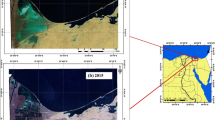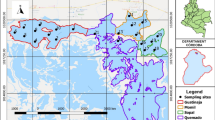Abstract
With the availability of satellite data from free data domain, remote sensing has increasingly become a fast-hand tool for monitoring of land and water resources development activities with minimal cost and time. Here, we verified construction of check dams and implementation of plantation activities in two districts of Tripura state using Landsat and Sentinel-2 images for the years 2008 and 2016–2017, respectively. We applied spectral reflectance curves and index-based proxies to quantify these activities for two time periods. A subset of the total check dams and plantation sites was chosen on the basis of site condition, nature of check dams, and planted species for identification on satellite images, and another subset was randomly chosen to validate identification procedure. The normalized difference water index (NDWI) derived from Landsat and Senitnel-2 were used to quantify water area evolved, qualify the water quality, and influence of associated tree shadows. Three types of check dams were observed, i.e., full, partial, and fully soil exposed on the basis of the presence of grass or scrub on the check dams. Based on the nature of check dam and site characteristics, we classified the water bodies under 11-categories using six interpretation keys (size, shape, water depth, quality, shadow of associated trees, catchment area). The check dams constructed on existing narrow gullies totally covered by branches or associated plants were not identified without field verification. Further, use of EVI enabled us to approve the plantation activities and adjudge the corresponding increase in vegetation vigor. The plantation activities were established based on the presence and absence of existing vegetation. Clearing on the plantation sites for plantation shows differential increase in EVI values during the initial years. The 403 plantation sites were categorized into 12 major groups on the basis of presence of dominant species and site conditions. The dominant species were Areca catechu, Musa paradisiaca, Ananas comosus, Bambusa sp., and mix plantation of A. catechu and M. paradisiaca. However, the highest maximum increase in average EVI was observed for the pine apple plantation sites (0.11), followed by Bambussa sp. (0.10). These sites were fully covered with plantation without any exposed soil. The present study successfully demonstrates a satellite-based survey supplemented with ground information evaluating the changes in vegetation profile due to plantation activities, locations of check dams, extent of water bodies, downstream irrigation, and catchment area of water bodies.











Similar content being viewed by others
References
Behera, M. D., Tripathi, P., Das, P., Srivastava, S. K., Roy, P. S., Joshi, C., Behera, P. R., Deka, J., Kumar, P., Khan, M. L., Tripathi, O. P., Dash, T., & Krishnamurthy, Y. V. N. (2017). Remote sensing based deforestation analysis in Mahanadi and Brahmaputra river basin in India since 1985. Journal of Environmental Management, 206, 1192–1203. https://doi.org/10.1016/j.jenvman.2017.10.015.
Clark, M. L., & Aide, T. M. (2010). Virtual interpretation of Earth Web-Interface Tool (VIEW-IT) for collecting land-use/land-cover reference data. Remote Sensing, 3(3), 601–620.
Das, S., & Das, M. (2014). Shifting cultivation in Tripura—a critical analysis. Journal of Agriculture and Life Sciences, 1(1), 48–54.
Das, P., Behera, M. D., Srivastava, S. K., Roy, P. S., Patidar, N., Sahoo, B., et al. (2018). Impact of LULC change on the runoff, baseflow and evapotranspiration in eastern Indian River basins using variable infiltration capacity approach. Journal of Earth System Science, 127(2), 19.
Green, K., Kempka, D., & Lackey, L. (1994). Using remote sensing to detect and monitor land-cover and land-use change. Photogrammetric Engineering and Remote Sensing, 60(3), 331–337.
Gupta, A. K. (2000). Shifting cultivation and conservation of biological diversity in Tripura. Northeast India. Human Ecology, 28(4), 605–629.
Kimes, D. S., Holben, B. N., Tucker, C. J., & Newcomb, W. W. (1984). Optimal directional view angles for remote-sensing missions. International Journal of Remote Sensing, 5, 887–908.
Ramakrishnan, P. S., & Toky, O. P. (1981). Soil nutrient status of hill agro-ecosystems and recovery pattern after slash and burn agriculture (jhum) in north-eastern India. Plant and Soil, 60(1), 41–64.
Ray, D., Behera, M. D., & Jacob, J. (2014). Indian Brahmaputra Valley offers significant potential for cultivation of rubber tree. Current Science, 107(3), 461–469.
Roy, P. S., Roy, A., Joshi, P. K., Kale, M. P., Srivastava, V. K., Srivastava, S. K., et al. (2015a). Development of decadal (1985–1995–2005) land use and land cover database for India. Remote Sensing, 7, 2401–2430. https://doi.org/10.3390/rs70302401.
Roy, P. S., Behera, M. D., Murthy, M. S. R., Roy, A., Singh, S., Kushwaha, S. P. S., et al. (2015b). New vegetation type map of India prepared using satellite remote sensing: Comparison with global vegetation maps and utilities. International Journal of Applied Earth Observation and Geoinformation, 39, 142–159. https://doi.org/10.1016/j.jag.2015.03.003.
Sawaya, K. E., Olmanson, L. G., Heinert, N. J., Brezonik, P. L., & Bauer, M. E. (2003). Extending satellite remote sensing to local scales: Land and water resource monitoring using high-resolution imagery. Remote Sensing of Environment, 88(1–2), 144–156.
Xiuwan, C. (2002). Using remote sensing and GIS to analyse land cover change and its impacts on regional sustainable development. International Journal of Remote Sensing, 23(1), 107–124.
Acknowledgements
The financial assistance received from Indo-German Development Cooperation Project, Tripura state forest department in form of an evaluation and monitoring project is thankfully acknowledged. The support and help rendered by the field and project management staff in carrying out the study is thankfully acknowledged. Debabrata Behera (Pondicherry University) and Sanjay Kumar Mahawar (COARL, Indian Institute of Technology Kharagpur, Kharagpur, India) helped in arranging the field photographs are also thankfully acknowledged.
Author information
Authors and Affiliations
Corresponding author
Electronic supplementary material
Fig. S1
Methodological flow diagram describing the overall procedure adopted to identify the water areas increased due to construction of check dams and increase in vegetation cover due to plantation (JPG 428 kb)
Rights and permissions
About this article
Cite this article
Behera, M.D., Gupta, A.K., Barik, S.K. et al. Use of satellite remote sensing as a monitoring tool for land and water resources development activities in an Indian tropical site. Environ Monit Assess 190, 401 (2018). https://doi.org/10.1007/s10661-018-6770-8
Received:
Accepted:
Published:
DOI: https://doi.org/10.1007/s10661-018-6770-8




